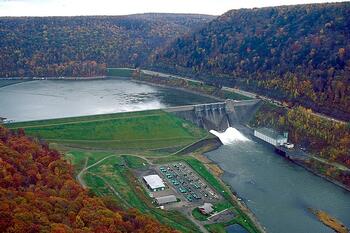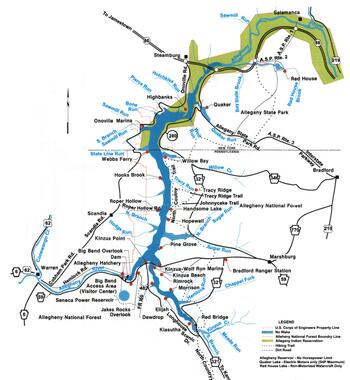The Allegheny River flows into New York from Pennsylvania, through the town of Olean, and back into Pennsylvania to the west. The potential flooding in western Pennsylvania was avoided by the Allegheny Reservoir, which was the result of the Kinzua Dam.
Construction of the Kinzua Dam was begun in 1960 despite protests by and in violation of a treaty with the Seneca Nation, which lost 10,000 acres of farmland and 600 people their homes to the resulting lake. Despite being protected by a 1794 treaty signed by George Washington, numerous legal suits and appeals, and the proposal of alternative plans to prevent flooding without displacing the Seneca community, Seneca villages along the river were burned in preparation for the dam’s construction. The forced evacuation from their ancestral land is remembered as a cause of continuing cultural trauma to the Seneca people, and a direct attack on their right to existence, autonomy, and respect.
USACE Kinzua Dam upriver. Courtesy of the U.S. Army Corps of Engineers Digital Visual Library on Wikimedia Commons.
Kinzua Dam on the Allegheny River in Warren County near Warren, Pennsylvania. The dam was constructed by the U.S. Army Corps of Engineers between 1960 and 1965. The dam provides flood control on the Allegheny River and Ohio River, and hydroelectric power production. The dam impounds the Allegheny Reservoir, also known as Kinzua Lake.
Kinzua Dam & Allegheny Reservoir. Courtesy of the U.S. Army Corps of Engineers, Pittsburgh District.
This map is from a promotional brochure about the dam and neighboring public parks, such as the Allegheny National Forest and the Onoville Marina Park. The map shows the Allegheny River's path from Salamanca in Cattaraugus County south into Pennsylvania. Kinzua Dam is in the bottom third of the map, near the blue circle.

